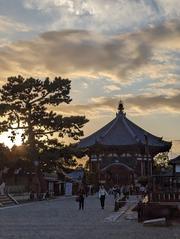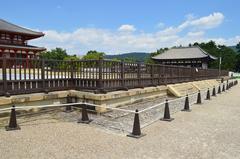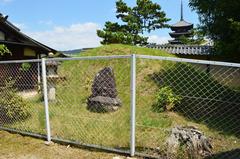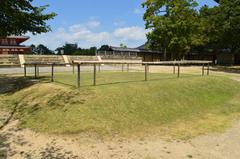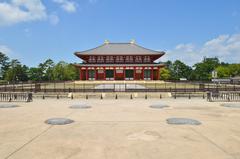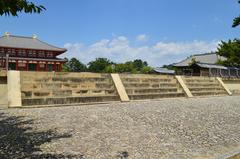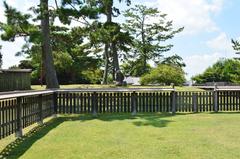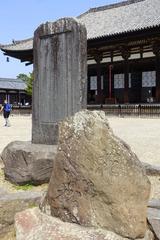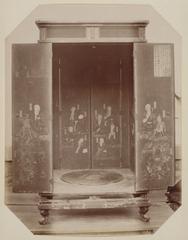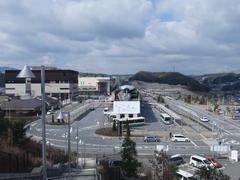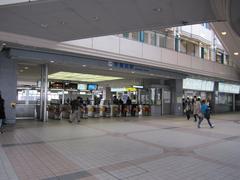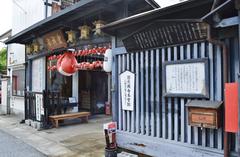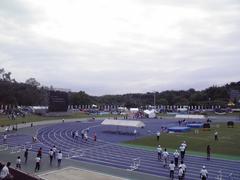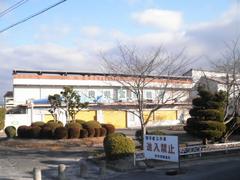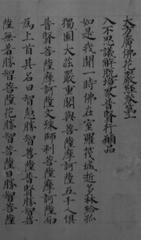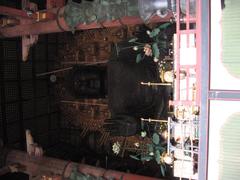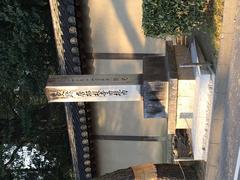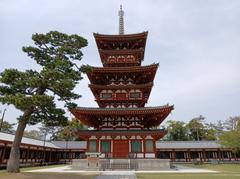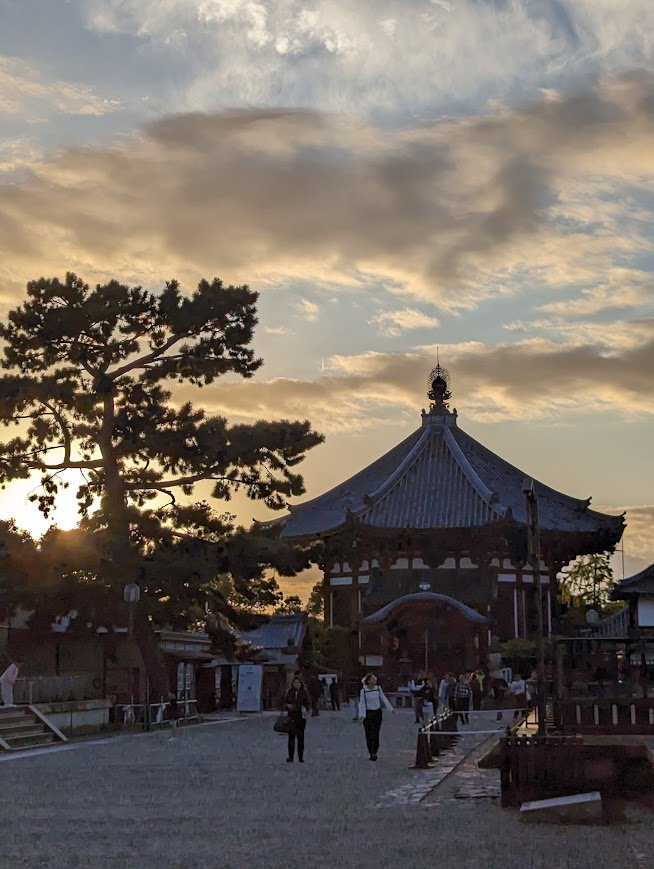
Kōfuku-ji Visiting Hours, Tickets, and Comprehensive Guide to Nara’s Historical Sites
Date: 14/06/2025
Introduction
Kōfuku-ji, nestled at the heart of Nara, Japan, is a testament to the country’s profound Buddhist heritage, political history, and architectural brilliance. Founded in 669 CE by the wife of Fujiwara no Kamatari, the temple has been at the center of Japan’s cultural and spiritual evolution, intimately tied to the influential Fujiwara clan and the development of the Hossō (Yogācāra) school of Buddhism. Today, as one of the Seven Great Temples of Nara and a UNESCO World Heritage Site, Kōfuku-ji draws visitors with its breathtaking pagodas, halls, and invaluable artifacts, offering a deeply immersive experience in Japanese history and culture (World History Encyclopedia; Visit Japan Travel; Japan Travel).
This detailed guide covers Kōfuku-ji’s history, architectural highlights, practical information on visiting hours and tickets, accessibility features, travel tips, and nearby attractions, ensuring you make the most of your visit to this Nara landmark.
Table of Contents
Historical Overview
Origins and Development
Kōfuku-ji was founded in 669 CE by Kagami-no-Ōkimi, wife of Fujiwara no Kamatari, as a prayer for her husband’s recovery (Wikipedia). Initially established in Yamashina (Kyoto), the temple moved to Fujiwara-kyō in 672 CE and then to Nara in 710 CE to coincide with the city’s new status as Japan’s capital. This move cemented Kōfuku-ji’s position as a spiritual and political centerpiece of early Japan (World History Encyclopedia).
The Fujiwara Clan’s Influence
As the ujidera (family temple) of the Fujiwara, Kōfuku-ji was both a religious sanctuary and a locus of courtly power during the Nara and Heian periods. The Fujiwara’s patronage endowed the temple with vast lands and influence, making it a formidable force in regional politics. At its zenith, Kōfuku-ji comprised over 150 buildings and maintained a private army of warrior monks, demonstrating its reach beyond the spiritual realm (World History Encyclopedia; Visit Japan Travel).
Religious and Cultural Significance
Kōfuku-ji is a principal site for the Hossō school of Buddhism, introduced by Dōshō in the 7th century. The temple became a center for Buddhist doctrine, scholarship, and ritual. Its monks were instrumental in the early development of Noh theater, and its annual festivals—such as the Oni Oshi Festival and Buddha’s Birthday—continue centuries-old spiritual traditions (World History Encyclopedia; Visit Japan Travel).
Architectural Highlights
Kōfuku-ji’s architecture is marked by cycles of destruction and renewal, with only a fraction of its original structures surviving today (Wikipedia). Notable features include:
- Five-Story Pagoda: Standing 50 meters tall, this iconic pagoda, rebuilt in 1426, is Japan’s second tallest and a symbol of Nara. As of 2025, it is under restoration, with completion expected in 2031 (explorenara.com; narashikanko.or.jp).
- Central Golden Hall (Chūkondō): Restored in 2018, the hall enshrines Yakushi Nyorai and four guardian deities (Visit Japan Travel).
- Eastern Golden Hall (Tōkondō): Houses significant Buddhist statues and is renowned for its architectural heritage (japan-guide.com).
- Northern and Southern Octagonal Halls: The Hokuendō (1210) and Nan’endō (1789) are unique octagonal structures, with Nan’endō open to the public only on October 17 each year (offthetrackjapan.com).
- National Treasure Museum: Home to masterpieces like the Ashura statue, one of Japan’s most revered Buddhist sculptures (nomadasaurus.com; ashigarukumakichi.com).
Periods of Decline and Restoration
Kōfuku-ji experienced periods of destruction, particularly during the Genpei War and through repeated fires. Many buildings were never rebuilt. The Edo period saw a revival of the temple’s fortunes, and modern restoration efforts, notably the 2018 completion of the Central Golden Hall, have preserved its legacy (Lala Love Nippon; Wikipedia).
Visitor Information
Hours and Ticketing
- Temple Grounds: Open 24 hours; free admission (Japan Travel).
- National Treasure Museum: 9:00 AM – 5:00 PM (last entry 4:45 PM); 700 JPY.
- Central Golden Hall: 9:00 AM – 5:00 PM (last entry 4:30 PM); 500 JPY.
- Eastern Golden Hall: 9:00 AM – 5:00 PM (last entry 4:30 PM); 300 JPY.
- Combination Tickets: Available on-site; adults 900 JPY (Visit Nara).
- Payment: Cash only; credit cards not accepted.
Accessibility
- Wheelchair Access: Main paths and National Treasure Museum are wheelchair-friendly. Some historic buildings have steps; assistance may be necessary (Visit Nara).
- Restrooms: Accessible facilities available on site.
- Guidance: English signage is present but limited; consider downloading a translation app.
Guided Tours and Events
- English-language tours: Can be arranged in advance via local agencies or the temple’s website (Kanpai Japan).
- Annual Events: Seasonal illuminations in February, Buddha’s Birthday in April, and the annual Nan’endō opening in October (offthetrackjapan.com).
Travel Tips
- Best Times to Visit: Early mornings, weekdays, or outside major holidays for fewer crowds; cherry blossom (late March–early April) and autumn foliage (late October–November) are especially scenic (Solo Sophie).
- Transportation: 5 min walk from Kintetsu Nara Station; 15–20 min from JR Nara Station; local buses stop at Kencho-mae (Kanpai Japan).
- Facilities: No food inside the temple, but Sanjo Dori nearby offers dining options (Wanderlog).
- Wi-Fi: Not guaranteed; pocket Wi-Fi rental recommended.
Must-See Features
- Five-Story Pagoda (japan-guide.com): Japan’s second tallest; currently under restoration (2025–2031).
- Central Golden Hall (Chūkondō) (explorenara.com): Reconstructed in 2018, spiritual center of the complex.
- Eastern Golden Hall (Tōkondō) (japan-guide.com): Important Buddhist statues.
- National Treasure Museum (Kokuhōkan) (nomadasaurus.com; narashikanko.or.jp): Features the Ashura statue and other priceless treasures.
- Octagonal Halls (offthetrackjapan.com): Distinctive architecture and limited annual access.
- Sarusawa Pond (japanrar.com): Picturesque reflections of the pagoda, especially at sunset.
Getting There
- Address: 48 Noborioji-cho, Nara City, Nara Prefecture
- From Kintetsu Nara Station: 5-minute walk
- From JR Nara Station: 15–20-minute walk or local bus
FAQs
Q: Can I purchase tickets online?
A: No, all tickets are sold on-site. Visit early to avoid lines.
Q: Are guided tours available in English?
A: Yes, bookable in advance through agencies or the temple website.
Q: Is the temple accessible for wheelchair users?
A: Most paths and the museum are accessible; some historic buildings have steps.
Q: Can I pay by credit card?
A: No, cash only.
Q: When is the Five-Story Pagoda under restoration?
A: 2025–2031; it may be partially covered by scaffolding (explorenara.com).
Q: Are photos allowed?
A: Outdoors, yes. Indoors (museum/halls), generally not—always check signage.
References
- Kōfuku-ji, World History Encyclopedia
- Kōfuku-ji, Wikipedia
- Visit Japan Travel: Kōfuku-ji
- Japan Travel: Kōfuku-ji
- Boutique Japan: Nara Travel Guide
- explorenara.com
- narashikanko.or.jp
- nomadasaurus.com
- ashigarukumakichi.com
- offthetrackjapan.com
- japan-guide.com
- Solo Sophie
- Kanpai Japan
- Wanderlog
- Lala Love Nippon
Kōfuku-ji stands as a living symbol of Japan’s spiritual and cultural resilience. With its harmonious blend of history, art, and natural beauty, the temple complex is a must-visit destination for anyone exploring Nara. Remember to check restoration updates, arrive early for a quieter experience, and take time to appreciate both the treasures inside and the tranquil scenery outside. For the latest information, guided audio tours, and travel updates, download the Audiala app and follow our channels.
